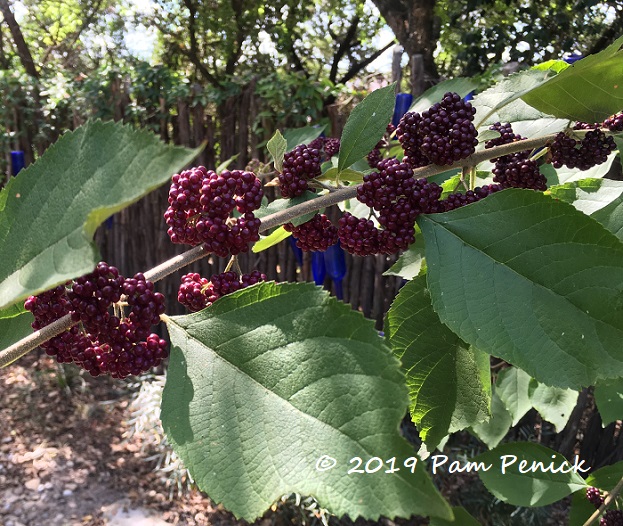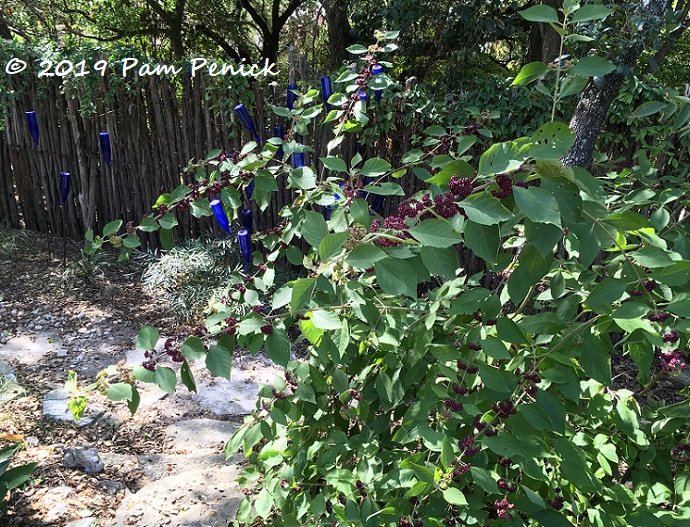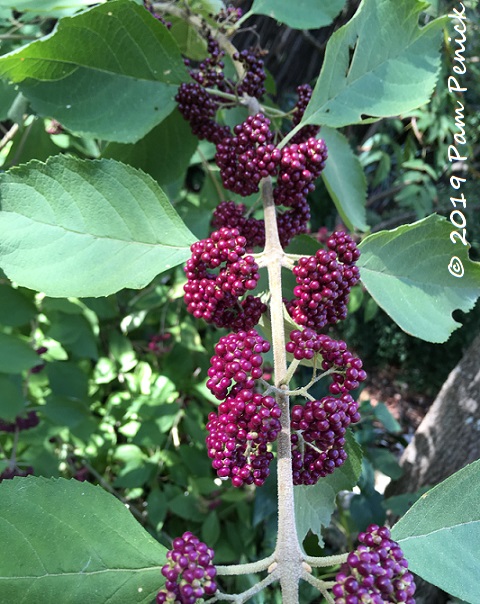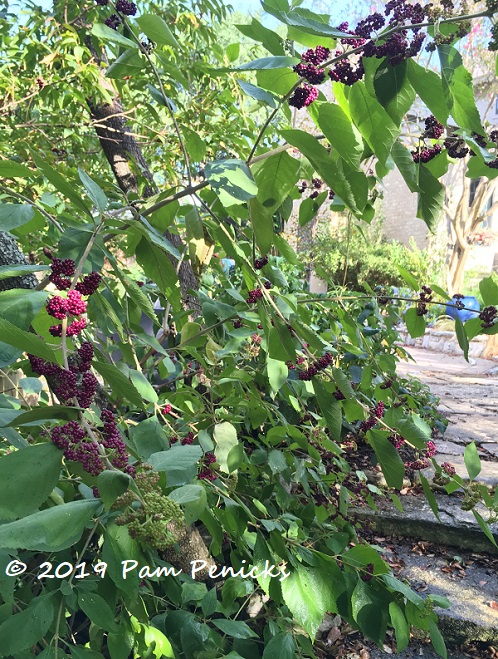Plant This: Mexican beautyberry

I am not, in general, a plant collector. I rarely make impulse buys at the nursery. And yet a few plants (agave, mangave, and Turk’s cap come to mind) have captivated me enough to try different varieties, even if I don’t exactly need or have space for another one.
Beautyberry (Callicarpa spp.) makes my list too. Why? Because it thrills me every year in late summer to see its arching stems loaded with masses of purple berries, a harbinger of cooler weather. Native to the U.S. Southeast, American beautyberry (Callicarpa americana) grows in shady gardens throughout Austin, putting on a show that lasts for a couple of weeks to a couple of months, depending on how long it takes for mockingbirds to discover the ripe fruit.

Other varieties of beautyberry intrigue me too, including white beautyberry (C. americana var. lactea) and this one — Mexican beautyberry (Callicarpa acuminata), also commonly known as black beautyberry. Mexican beautyberry is tall, dark, and handsome. It reached 8 feet tall by its third year in my garden and equally wide. It may grow even larger, but I’ve had to prune it back a bit from my paths, which I regret doing, as the arching stems are so pretty.

The fruit of Mexican beautyberry turns a dark mulberry rather than the bright magenta of the American species. According to Woodlanders Nursery, “It was collected in Mexico by the late and great Texas plantsman Lynn Lowery and perhaps first offered to the international market by Woodlanders.” I found mine in 2014 at Green ‘n Growing Nursery in Pflugerville.

Like American beautyberry, Mexican beautyberry loves shade or a little morning sun, and it makes a pretty understory plant if you have lots of trees. Just remember that it gets big, so give it plenty of space to do its thing — at least 8 feet. It prefers regular water, but it’ll tolerate dry periods once established, although be warned that it will droop and pout. Its fruit ripens a few weeks later than that of American beautyberry in my garden, and I’m still enjoying its dark berries even after the mockingbirds have stripped the American.
I can’t begrudge the birds their feast though. Better to rejoice in making one’s garden more attractive to our feathered friends!
Note: My Plant This posts are written primarily for gardeners in Central Texas. The plants I recommend are ones I’ve grown myself and have direct experience with. Check online forums for your region or local independent nurseries to see if a particular plant might work in your area.
__________________________
Digging Deeper
Come learn about gardening and design at Garden Spark! I organize in-person talks by inspiring designers, landscape architects, authors, and gardeners a few times a year in Austin. These are limited-attendance events that sell out quickly, so join the Garden Spark email list to be notified in advance; simply click this link and ask to be added. Season 8 kicks off in fall 2024. Stay tuned for more info!
All material © 2025 by Pam Penick for Digging. Unauthorized reproduction prohibited.


A gardener a little south of here had one of the most impressive and beautiful effects I’ve ever seen, that peaked in November: a hedge of American beautyberry along his long, uphill driveway. For years, he grew C. americana from seed and selected for the most abundant and darkest berries (easier and easier as the dark selections became the parents). The color was very like the Mexican beautyberry in your images. Enough to make a show even after mockingbirds had their fill!
I have a white form on my wishlist. They grow well as cutback shrubs, I read, because they bloom best on new wood — so are easy to keep to a manageable size in a border.
You’ve shared two interesting ideas, one for design and one for pruning — thanks! I’ve always thought of American beautyberry as a shrub that it’s better not to prune because the broad, arching shape of the plant is so pretty. So I’m intrigued by the idea of growing the white form as a cutback shrub. If you find one and end up growing it that way, I’ll hope you’ll come back with a report.
My understanding and hope is that they will grow out to an arching shape within a season, flowering/berrying all the more densely because all the growth is new. Will report back if I get a Callicarpa into the ground… Probably wouldn’t do the cutback thing until after it survived a winter. Gardening really does give a person reasons to look forward!
For some reason, one never sees these plants here, and believe me I’ve looked for them.
Perhaps because you’re so much drier in L.A.? Callicarpa is a Southeastern native of woodlands and streamsides. I suspect that Austin is on the western edge of its native range.
My beauty berry has much lighter purple berries. They too are enjoyed by robins and mockingbirds. It is fun to watch them tussle over the berries. Another berry shrub I like is Snowberry. I think there is a different native for every state. I love to see those white berries and the birds don’t leave them for long.
I agree that it’s great to add berrying plants to the garden for the birds, as well as our own appreciation. Possumhaw is another good choice for my zone 8b.
A friend of mine in Houston had this plant at her garage door. It was always so stunning to see this. Thanks for bringing this back to attention of us gardeners. Just bought it at Amazon: Pearl Glam Beautyberry (Callicarpa) Live Shrub, Dark Purple Foliage and Violet-Purple Berries, 4.5 in. Quart
by Proven Winners
Now, where do I find a space?
That looks like a beauty, Karin. I looked up ‘Pearl Glam’ to learn more. It’s a cross between Callicarpa dichotoma and C. kwangtungensis and has a more upright shape than either C. americana or acuminata. Please let me know how it does for you!